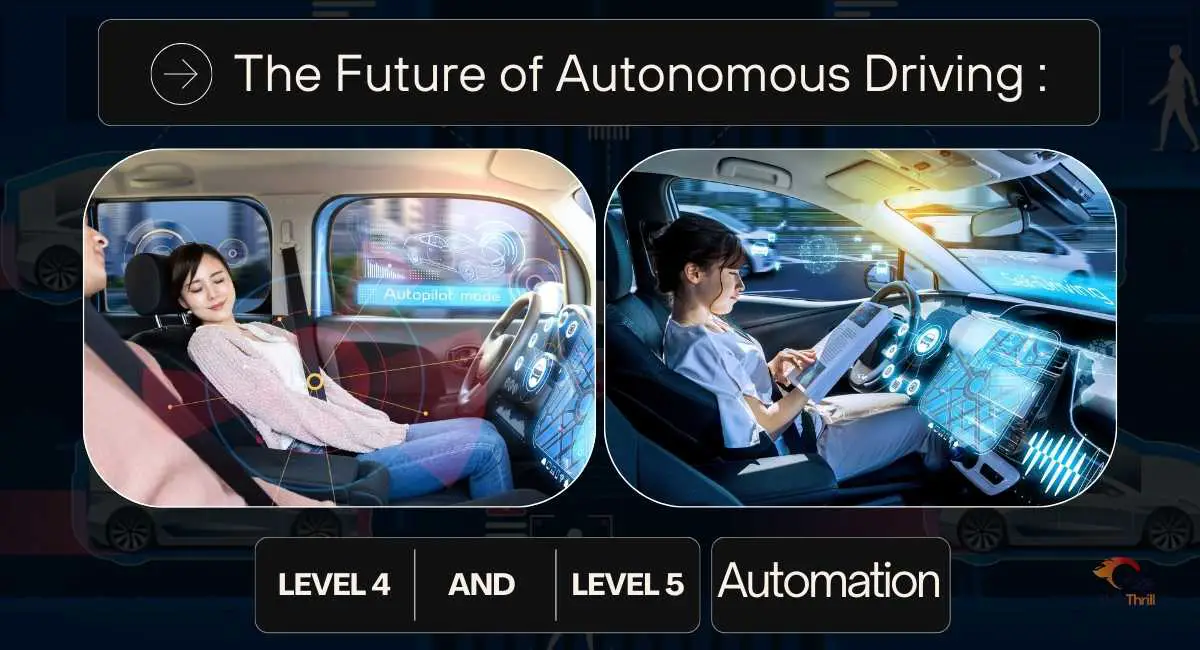In the not-too-distant future, the sight of self-driving cars navigating our streets may become commonplace. For instance, by 2035, the autonomous driving sector could generate revenue ranging from $300 billion to $400 billion.
But as we venture into autonomous driving, it’s crucial to understand the intricacies of Level 4 and Level 5 autonomy. These levels represent the pinnacle of vehicle automation, promising a future where human intervention is minimal, if not entirely unnecessary.
Unlike Level 4, a Level 5 vehicle operates entirely autonomously. It can navigate any road traffic scenario and withstand all weather conditions without human intervention. As a result, such vehicles no longer necessitate a steering wheel, brake pedal, or gas pedal.
Read on to understand the definitions and capabilities of Level 4 and Level 5 autonomy, the current state and future projections of autonomous vehicle technology, the legal and regulatory challenges, and the implications for transportation and society.

Definitions and Capabilities of Level 4 and Level 5 Autonomy
Autonomous driving can revolutionize transportation, consumer behavior, and society. Let’s now understand the future of autonomous driving, focusing on the definitions and capabilities of Level 4 and Level 5 automation:
Understanding Level 4 Autonomous Vehicles
Level 4 autonomy signifies a significant leap in vehicle automation. At this level, vehicles can operate without human intervention within specific operational design domains (ODDs). They can handle most driving situations independently, with a limited need for driver intervention.
However, a human driver must still be present and ready to take over if needed. Well, there’s more about the characteristics of Level 4 autonomous vehicles as described below:
Key Characteristics:
- Without constant human intervention, the vehicle operates autonomously within specific scenarios or environments, such as well-mapped urban areas or controlled highways.
- This advancement offers enhanced safety and convenience for specific use cases, while outside these predefined conditions, human control may be necessary, showcasing the limitations of Level 4 autonomy.
Consumer Impact:
- Level 4 autonomy introduces enhanced safety and convenience for consumers, mainly when autonomous operation is feasible.
- The innovation opens up possibilities for various commercial applications, such as autonomous delivery vehicles, potentially revolutionizing industries reliant on transportation.
- The growing demand for Level 4 systems presents a significant revenue opportunity, with billions of dollars potentially at stake for the automotive industry and related sectors.
Understanding Level 5 Autonomous Vehicles
Level 5 autonomy represents the ultimate goal of self-driving technology. Vehicles at this level can navigate all driving scenarios without any human input under any conditions. It includes complex urban environments, adverse weather conditions, and unpredictable situations on the road. These cars have no steering wheel, gas pedal, or brake pedal, which is necessary.
So, this level has several impacts on the consumer and the industry, as mentioned below:
Consumer Impact:
- Fully autonomous mobility for passengers, eliminating the need for driver intervention.
- There is no requirement for a driver’s license or driving skills, offering accessibility to all.
- It creates an opportunity to engage in other activities during travel, enhancing productivity and leisure.
- It can revolutionize urban planning and mobility patterns, redefining city landscapes and transportation dynamics.
Industry Impact:
- Level 4 offers significant value creation for the automotive sector, driven by consumer demand for autonomous features.
- Consumer willingness to pay for advancements in autonomous driving capabilities is fueling industry growth.
- It can generate revenue by continuously improving advanced driver-assistance systems (ADAS), leading to enhanced safety standards and accident prevention.
While Level 4 provides substantial benefits within specific contexts, Level 5 represents the ultimate vision of fully autonomous driving, where vehicles navigate independently without human input.
Current State and Future Projections of Autonomous Vehicle Technology
The current state of autonomous vehicle technology showcases remarkable advancements in sensors, perception systems, and artificial intelligence (AI) algorithms. Companies like Waymo, Tesla, and GM’s Cruise lead in testing and deploying autonomous vehicles. However, while there is significant progress, challenges remain.
Future projections indicate continuous improvements in sensor technology and AI capabilities. These advancements will pave the way for the widespread adoption of autonomous vehicles across various sectors, from ride-hailing services to logistics and delivery.
The current state of autonomous vehicle (AV) technology is exciting and transformative.
Safety and Convenience
Autonomous vehicles (AVs) promise to transform mobility, offering safer, more convenient, and enjoyable driving experiences. Envision utilizing your commute time for video calls, watching movies, or even working while the AV takes care of the driving. For individuals with lengthy commutes, AVs could boost productivity and lead to shorter workdays.
Moreover, elderly drivers stand to gain improved mobility beyond relying solely on public transportation or car-sharing services. Implementing advanced driver-assistance systems (ADAS) is already contributing to reducing accidents, and broader adoption could further enhance road safety.
Consumer Demand and Revenue
Consumers are eager to access AV features and are prepared to invest in them. Vehicles equipped with lidar-based Level 2+ (L2+) capabilities typically encompass component costs ranging from $1,500 to $2,000. According to Forbes, projections indicate that by 2030, approximately 12% of new passenger cars will have L3+ autonomous technologies, which will rise to 37% by 2035, incorporating advanced AD technologies.
Business Strategies and Value Creation
Auto OEMs and suppliers must devise innovative sales and business strategies to leverage the future adoption of autonomous vehicles (AVs). By the end of this decade, the implementation of autonomous driving (AD) technology can raise hundreds of billions of dollars in revenue for the auto industry. Critical determinants of success in the AD passenger car market encompass technological prowess and the effective management of safety apprehensions.
Future Projections
The primary business model is increasingly centered around fleets of robo-taxis, gaining considerable momentum. There is a significant potential for improved freight efficiency with the introduction of automated trucks.
Although congestion remains a challenge, connectivity, and user behavior are pivotal factors. Successful deployment of autonomous vehicles (AVs) relies heavily on stakeholder collaboration. While standards may adapt according to business requirements, proactive regulation plays a crucial role in shaping the development of AV technology.
AVs promise to transform transportation, consumer behavior, and society. Buckle up for an exciting ride into the future!
Legal and Regulatory Challenges
The legal and regulatory landscape surrounding autonomous vehicles (AVs) presents a complex maze of rules and standards that vary from region to region. Safety certifications, liability concerns, ethical dilemmas, and cybersecurity issues are among the multifaceted challenges that need addressing to ensure the safe and responsible deployment of Level 4 and Level 5 automation in AVs.
Diverse State and Federal Regulations
In the United States, the absence of a comprehensive federal regulatory framework for AVs has resulted in a patchwork of regulations at the state level. While many states have enacted laws to facilitate AV development and testing, the lack of uniformity poses challenges for manufacturers, suppliers, and sellers. Achieving consistency across jurisdictions is essential to foster innovation and ensure regulatory compliance.
Liability Considerations
Determining liability in autonomous vehicle accidents becomes increasingly complex as AVs become more autonomous. Traditional tort liability principles currently govern, but the evolution of liability rules remains uncertain—variance in product liability rules and regulations further complicate matters, impacting AV manufacturers and suppliers.
Cybersecurity and Data Privacy
The high levels of automation of AVs introduce significant safety, cybersecurity, and data privacy concerns. AVs rely heavily on software and connectivity, rendering them vulnerable to cyber threats. Safeguarding sensitive data and ensuring secure communication channels are critical challenges that need addressing to mitigate potential risks.
Technological Challenges
Achieving Level 4 and Level 5 automation necessitates the development of robust machine-learning algorithms and wireless communication systems. AVs must be capable of navigating diverse road conditions, weather patterns, and unexpected scenarios seamlessly. It is crucial to address these technological challenges to guarantee the reliability and safety of autonomous driving systems.
Federal vs. State Regulation
Finding the right balance between federal oversight and state flexibility is essential in regulating AVs effectively. While federal regulation should establish overarching safety standards and guidelines, states should have the flexibility to adapt rules to suit local contexts and needs. Collaboration between federal and state authorities is crucial to harmonize regulations and promote innovation in the AV industry.
Ethical and Social Norms
AVs make split-second decisions in emergencies, presenting ethical dilemmas that raise fundamental questions about societal values and norms. Balancing innovation with respect for individual rights and safety is a paramount challenge that requires careful consideration and dialogue among stakeholders.
Implications for Transportation and Society
The emergence of Level 4 and Level 5 autonomy signals a profound transformation in transportation, carrying significant societal implications. With the increasing prevalence of autonomous vehicles, a transition from conventional car ownership to Mobility as a Service (MaaS) is anticipated.
This shift will not only optimize traffic flow and reduce congestion but also improve accessibility to transportation for elderly and disabled individuals. However, the widespread adoption of autonomous vehicles may also lead to job displacement in the transportation industry, necessitating retraining and reskilling programs to mitigate the impact on workers. Additionally, changes in urban planning and infrastructure are a necessity to accommodate the integration of autonomous vehicles into our cities seamlessly.
AV technology presents significant economic opportunities. It fosters innovation and opens up avenues for startups and new business models. Companies specializing in AV software, sensors, and data analytics are poised to thrive in this evolving landscape.
What are the Leading Brands in the Development of Autonomous Vehicles?
The landscape of autonomous vehicles (AVs) is evolving rapidly, with numerous companies spearheading advancements in this transformative technology. Let’s delve into some of the foremost brands and their contributions to this field.
General Motors
GM makes cars, trucks, and other passenger vehicles across price points. They are also hard at work developing new automotive technology for self-driving cars. It is a majority owner of the autonomous car company Cruise.
Moreover, the Cruise Origin, an all-electric, self-driving vehicle, is set to be built at GM’s advanced Factory ZERO assembly plant.
Motional
Motional, based in Santa Monica, California, builds autonomous vehicles that use lidar and over 30 camera and radar sensors. Their focus is on ensuring 360-degree visibility and reliable object detection. Motional collaborates with top rideshare companies like Uber, Via, and Lyft to make driverless taxiing and delivery a reality.
Waymo
Waymo, headquartered in Mountain View, California, builds self-driving vehicles. They offer commuter vehicles and autonomous trucks for both personal and commercial use. Besides, Waymo uses custom mapping technology and real-time sensor data to navigate safely around pedestrians, traffic signs, and other vehicles.
Alphabet Inc.
Alphabet, Google’s parent company, has pioneered AV development. Their AV division, Waymo, has made significant strides in self-driving technology. Waymo’s focus on safety and advanced sensors sets them apart.
Nvidia
NVIDIA provides hardware and software solutions for AVs. Their powerful GPUs enable real-time processing of sensor data. Many AV developers use NVIDIA’s technology for perception and decision-making.
Baidu
Baidu, a Chinese tech giant, is investing heavily in AV research. They focus on AI, mapping, and autonomous driving technologies. Baidu Apollo is their open-source AV platform, collaborating with various partners.
Tesla, Inc.
Tesla, led by Elon Musk, has made waves in AV technology. Their Autopilot system and Full Self-Driving (FSD) features are widely known. Tesla’s electric vehicles have advanced sensors and software.
These companies and others are shaping the future of AVs, aiming for safer, more efficient transportation. You can always check them out for more information concerning the future of autonomous vehicles.
Conclusion
As we stand at the precipice of a new era in transportation, the future of autonomous driving holds immense promise and potential. Level 4 and Level 5 autonomy represent significant milestones in vehicle automation, with the capability to revolutionize how we travel and interact with our environment. However, realizing this vision will require addressing various challenges, including legal and regulatory hurdles, ethical considerations, and societal implications. By navigating these challenges thoughtfully and responsibly, we can unlock the full benefits of autonomous driving technology while ensuring the safety, accessibility, and sustainability of our transportation systems for generations to come.
